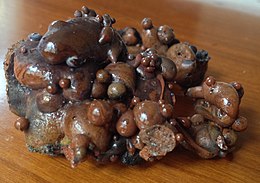
An impact crater is a circular depression in the surface of a solid astronomical body formed by the hypervelocity impact of a smaller object. In contrast to volcanic craters, which result from explosion or internal collapse, impact craters typically have raised rims and floors that are lower in elevation than the surrounding terrain. Impact craters range in size from microscopic craters seen on lunar rocks returned by the Apollo Program to simple bowl-shaped depressions and vast, complex, multi-ringed impact basins. Meteor Crater is a well-known example of a small impact crater on Earth.
A mineraloid is a naturally occurring substance that resembles a mineral, but does not demonstrate the crystallinity of a mineral. Mineraloid substances possess chemical compositions that vary beyond the generally accepted ranges for specific minerals, for example, obsidian is an amorphous glass and not a true crystal; lignite (Jet) is derived from the decay of wood under extreme pressure underground; and opal is a mineraloid substance because of its non-crystalline nature. Pearl is a mineraloid substance because the calcite crystals and the aragonite crystals are bonded by an organic material, and naturally occurs without definite proportions of the components.

Tektites are gravel-sized bodies composed of black, green, brown or grey natural glass formed from terrestrial debris ejected during meteorite impacts. The term was coined by Austrian geologist Franz Eduard Suess (1867–1941), son of Eduard Suess. They generally range in size from millimetres to centimetres. Millimetre-scale tektites are known as microtektites.

Fulgurites, commonly called "fossilized lightning", are natural tubes, clumps, or masses of sintered, vitrified, or fused soil, sand, rock, organic debris and other sediments that sometimes form when lightning discharges into ground. When composed of silica, fulgurites are classified as a variety of the mineraloid lechatelierite.
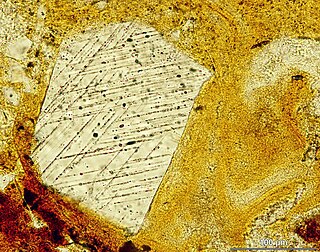
Shocked quartz is a form of quartz that has a microscopic structure that is different from normal quartz. Under intense pressure, the crystalline structure of quartz is deformed along planes inside the crystal. These planes, which show up as lines under a microscope, are called planar deformation features (PDFs), or shock lamellae.

Coesite is a form (polymorph) of silicon dioxide (SiO2) that is formed when very high pressure (2–3 gigapascals), and moderately high temperature (700 °C, 1,300 °F), are applied to quartz. Coesite was first synthesized by Loring Coes, Jr., a chemist at the Norton Company, in 1953.

Impactite is rock created or modified by one or more impacts of a meteorite. Impactites are considered metamorphic rock, because their source materials were modified by the heat and pressure of the impact. On Earth, impactites consist primarily of modified terrestrial material, sometimes with pieces of the original meteorite.

Albite is a plagioclase feldspar mineral. It is the sodium endmember of the plagioclase solid solution series. It represents a plagioclase with less than 10% anorthite content. The pure albite endmember has the formula NaAlSi
3O
8. It is a tectosilicate. Its color is usually pure white, hence its name from Latin, albus. It is a common constituent in felsic rocks.
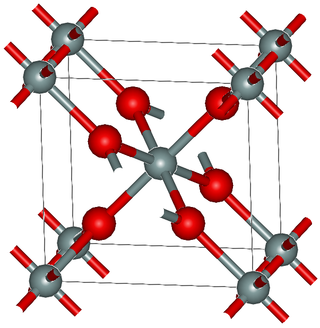
Stishovite is an extremely hard, dense tetragonal form (polymorph) of silicon dioxide. It is very rare on the Earth's surface; however, it may be a predominant form of silicon dioxide in the Earth, especially in the lower mantle.
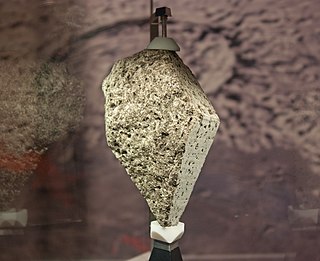
Moon rock or lunar rock is rock originating from Earth's Moon. This includes lunar material collected during the course of human exploration of the Moon, and rock that has been ejected naturally from the Moon's surface and landed on Earth as meteorites.

Libyan desert glass or Great Sand Sea glass is an impactite, made mostly of lechatelierite, found in areas in the eastern Sahara, in the deserts of eastern Libya and western Egypt. Fragments of desert glass can be found over areas of tens of square kilometers.

Clastic rocks are composed of fragments, or clasts, of pre-existing minerals and rock. A clast is a fragment of geological detritus, chunks, and smaller grains of rock broken off other rocks by physical weathering. Geologists use the term clastic to refer to sedimentary rocks and particles in sediment transport, whether in suspension or as bed load, and in sediment deposits.
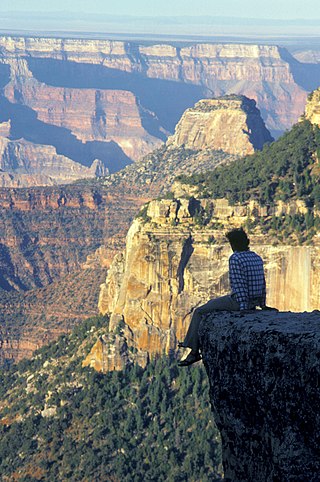
Coconino Sandstone is a geologic formation named after its exposure in Coconino County, Arizona. This formation spreads across the Colorado Plateau province of the United States, including northern Arizona, northwest Colorado, Nevada, and Utah.

Maskelynite is a glassy material found in some meteorites and meteorite impact craters. Typical samples are similar in composition to plagioclase feldspar, and revert to that mineral when melted and recrystallized. It was named after British geologist M.H.N. Story-Maskelyne.
Edward Ching-Te Chao was one of the founders of the field of impact metamorphism, the study of the effects of meteorite impacts on the Earth's crust.
Shock metamorphism or impact metamorphism describes the effects of shock-wave related deformation and heating during impact events.
Vitrified sand is sand that has been heated to a high enough temperature to undergo vitrification, which is the melting of the silicon dioxide or quartz that compose common sand. Vitrified sand is a type of natural glass, contrasted with manufactured glass in which soda ash or potash are added to lower the melting point. Pure quartz melts at 1,650 °C (3,002 °F). There are several natural processes that produce more or less melted sand and one man-made form:

Seifertite is a silicate mineral with the formula SiO2 and is one of the densest polymorphs of silica. It has only been found in Martian and lunar meteorites, where it is presumably formed from either tridymite or cristobalite – other polymorphs of quartz – as a result of heating during the atmospheric re-entry and impact to the Earth, at an estimated minimal pressure of 35 GPa. It can also be produced in the laboratory by compressing cristobalite in a diamond anvil cell to pressures above 40 GPa. The mineral is named after Friedrich Seifert (born 1941), the founder of the Bayerisches Geoinstitut at University of Bayreuth, Germany, and is officially recognized by the International Mineralogical Association.
Reidite is a rare polymorph of ZrSiO4 created when zircon experiences high pressure and temperature. Reidite is denser than zircon and has the same crystal structure as scheelite. All natural occurrences of reidite are associated with meteorite impact events.
Hypatia is a small stone found in Egypt in 1996. It has been claimed to be both a meteorite and kimberlite debris. It has also been claimed to be the first known specimen of a comet nucleus on Earth, although defying physically-accepted models for hypervelocity processing of organic material. As of November 2023, Hypatia has not been officially classified as a meteorite in the Meteoritical Bulletin, which is tasked with recording all scientifically proven meteorites.
